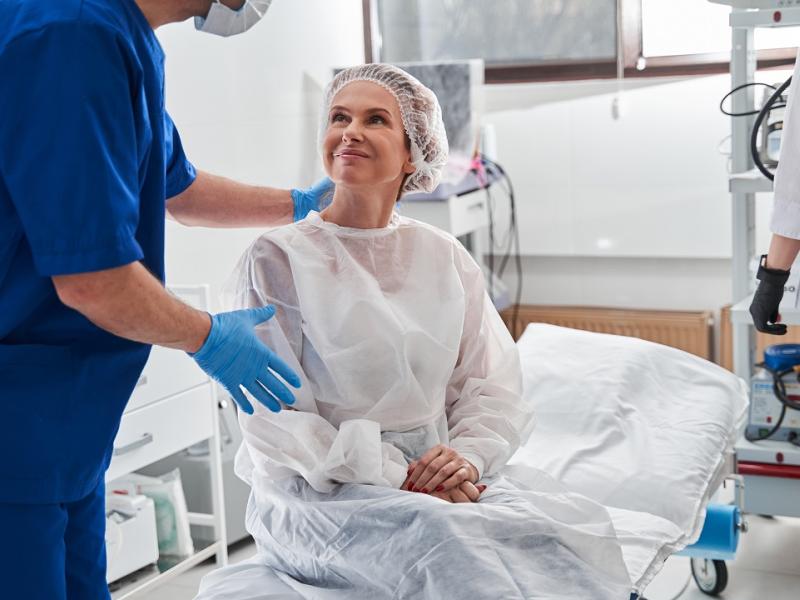Dysphoric milk ejection reflex (D-MER) is a condition that causes sudden negative emotions during...
Read More
Are you experiencing persistent pelvic pain or heavy menstrual bleeding? Uterine fibroids can significantly affect your daily life, but personalized treatment and compassionate care can help you get relief and improve your well-being.
Uterine fibroids, also called uterine leiomyomas or myomas, are non-cancerous growths in or around the uterus. These growths arise from the smooth muscle cells of the uterine wall and can vary in size, from tiny seedlings undetectable to the human eye to large masses that can distort and enlarge the uterus.
Although researchers don’t understand the exact cause of uterine fibroids, they may be influenced by hormones, especially estrogen and progesterone, which can stimulate uterine fibroid growth. Genetics may play a role in uterine fibroid development, as they tend to run in families.
Uterine fibroids can grow in various uterine locations. Each type can affect the body differently:
Located beneath the lining of the uterine cavity, these fibroids can protrude into the uterine space. They are the least common type but often cause significant symptoms like heavy menstrual bleeding and fertility issues.
Found within the muscular wall of the uterus, intramural fibroids are the most common type. They can cause the uterus to appear larger and may lead to heavy menstrual bleeding, pelvic pain and pressure.
These fibroids grow on the outer uterine surface and can continue to expand outward. Subserosal fibroids may not affect menstrual flow as much as other types, but they can cause pelvic pain, pressure and sometimes back pain, depending on their size and location.
Attached to the outer or inner wall of the uterus by a thin stalk, these fibroids can cause sudden, sharp pain if the stalk becomes twisted. Depending on their location, they can also contribute to the symptoms associated with subserosal or submucosal fibroids.
Depending on size, location and quantity, uterine fibroids can cause a range of symptoms, including:
Diagnosing uterine fibroids starts with a thorough medical history and a pelvic exam. During the exam, the doctor may feel irregularities in the uterus shape, which can indicate the presence of uterine fibroids. You may need imaging tests, such as ultrasounds, MRIs or CT scans, to confirm diagnosis and gather more details about your condition. Your doctor may also perform a biopsy or hysteroscopy if they need more information. Early and accurate diagnosis can help your care team develop an effective treatment plan so you can manage fibroid symptoms.


Medications such as hormonal therapies can help regulate your menstrual cycle and manage symptoms like heavy bleeding and pelvic pain. They work by reducing estrogen levels or blocking its effects, which can shrink uterine fibroids and alleviate discomfort.

In cases where uterine fibroids are large or cause severe symptoms, your doctor may recommend surgical removal while leaving the uterus intact (called myomectomy) or removing the uterus (called hysterectomy ). These procedures are more invasive but can provide long-term relief for those experiencing significant uterine fibroid-related symptoms.

Minimally invasive procedures like uterine artery embolization (UAE) or focused ultrasound surgery (FUS) are targeted approaches that can shrink or destroy uterine fibroids. These techniques offer shorter recovery times and less risk.
At Inspira, we ensure each patient receives personalized care from an experienced, multidisciplinary team. We understand that uterine fibroids can present differently for each individual, so our treatment plans are customized to target specific symptoms and improve overall quality of life.
Whether you're experiencing heavy menstrual bleeding, pelvic pain or other fibroid-related symptoms, we see you and are committed to providing effective relief. Our goal is to empower you with the knowledge and support needed to make informed decisions about your health, ensuring you receive compassionate care and optimal outcomes throughout your treatment journey.
Several factors can increase the risk of developing uterine fibroids, including age, family history and hormonal influences, such as estrogen and progesterone levels. Obesity and ethnicity may also play a role.
Heavy menstrual bleeding is a common symptom of uterine fibroids that may result in iron deficiency anemia over time. Heavy bleeding can cause the body to lose more iron than it can replace, leading to fatigue, weakness and shortness of breath. Managing fibroid-related bleeding through various treatment options, including medication or surgical interventions, can help prevent or alleviate anemia associated with uterine fibroids.
Untreated uterine fibroids can potentially grow larger over time, leading to worsened symptoms such as heavy menstrual bleeding, pelvic pain and pressure on surrounding organs. In some cases, untreated uterine fibroids may affect fertility by distorting the uterine cavity or blocking the fallopian tubes. Early diagnosis and personalized treatment plans tailored to individual symptoms can help manage uterine fibroids effectively and minimize their impact on daily life.
Uterine fibroids can grow large enough to increase your overall abdominal size slightly, but they don’t typically cause weight gain. Some people may experience bloating or a feeling of abdominal fullness, which can be mistaken for weight gain. Understanding the distinction can help alleviate concerns and focus on managing symptoms through appropriate treatment options tailored to individual needs.

Dysphoric milk ejection reflex (D-MER) is a condition that causes sudden negative emotions during...
Read More
Polycystic Ovary Syndrome (PCOS) affects millions, yet many misconceptions still surround this...
Read More
From midwives and obstetricians to nurse practitioners and birthing coaches, here are the...
Read More
The material set forth in this site in no way seeks to diagnose or treat illness or to serve as a substitute for professional medical care. Please speak with your health care provider if you have a health concern or if you are considering adopting any exercise program or dietary guidelines. For permission to reprint any portion of this website or to be removed from a notification list, please contact us at (856) 537-6772